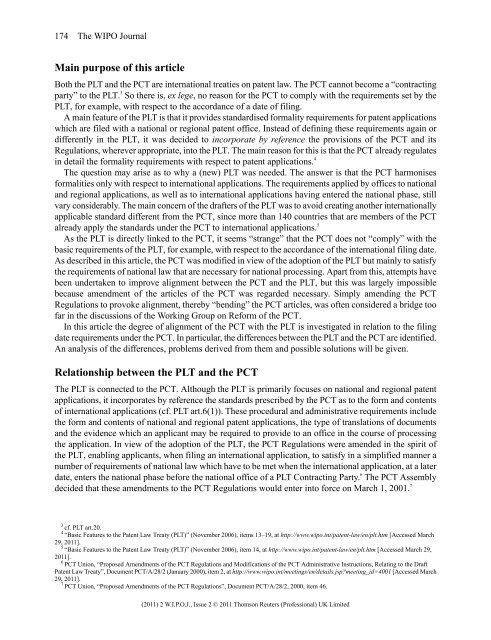WIPO Journal - World Intellectual Property Organization
WIPO Journal - World Intellectual Property Organization
WIPO Journal - World Intellectual Property Organization
Create successful ePaper yourself
Turn your PDF publications into a flip-book with our unique Google optimized e-Paper software.
174 The <strong>WIPO</strong> <strong>Journal</strong><br />
Main purpose of this article<br />
Both the PLT and the PCT are international treaties on patent law. The PCT cannot become a “contracting<br />
party” to the PLT. 3 So there is, ex lege, no reason for the PCT to comply with the requirements set by the<br />
PLT, for example, with respect to the accordance of a date of filing.<br />
A main feature of the PLT is that it provides standardised formality requirements for patent applications<br />
which are filed with a national or regional patent office. Instead of defining these requirements again or<br />
differently in the PLT, it was decided to incorporate by reference the provisions of the PCT and its<br />
Regulations, wherever appropriate, into the PLT. The main reason for this is that the PCT already regulates<br />
in detail the formality requirements with respect to patent applications. 4<br />
The question may arise as to why a (new) PLT was needed. The answer is that the PCT harmonises<br />
formalities only with respect to international applications. The requirements applied by offices to national<br />
and regional applications, as well as to international applications having entered the national phase, still<br />
vary considerably. The main concern of the drafters of the PLT was to avoid creating another internationally<br />
applicable standard different from the PCT, since more than 140 countries that are members of the PCT<br />
already apply the standards under the PCT to international applications. 5<br />
As the PLT is directly linked to the PCT, it seems “strange” that the PCT does not “comply” with the<br />
basic requirements of the PLT, for example, with respect to the accordance of the international filing date.<br />
As described in this article, the PCT was modified in view of the adoption of the PLT but mainly to satisfy<br />
the requirements of national law that are necessary for national processing. Apart from this, attempts have<br />
been undertaken to improve alignment between the PCT and the PLT, but this was largely impossible<br />
because amendment of the articles of the PCT was regarded necessary. Simply amending the PCT<br />
Regulations to provoke alignment, thereby “bending” the PCT articles, was often considered a bridge too<br />
far in the discussions of the Working Group on Reform of the PCT.<br />
In this article the degree of alignment of the PCT with the PLT is investigated in relation to the filing<br />
date requirements under the PCT. In particular, the differences between the PLT and the PCT are identified.<br />
An analysis of the differences, problems derived from them and possible solutions will be given.<br />
Relationship between the PLT and the PCT<br />
The PLT is connected to the PCT. Although the PLT is primarily focuses on national and regional patent<br />
applications, it incorporates by reference the standards prescribed by the PCT as to the form and contents<br />
of international applications (cf. PLT art.6(1)). These procedural and administrative requirements include<br />
the form and contents of national and regional patent applications, the type of translations of documents<br />
and the evidence which an applicant may be required to provide to an office in the course of processing<br />
the application. In view of the adoption of the PLT, the PCT Regulations were amended in the spirit of<br />
the PLT, enabling applicants, when filing an international application, to satisfy in a simplified manner a<br />
number of requirements of national law which have to be met when the international application, at a later<br />
date, enters the national phase before the national office of a PLT Contracting Party. 6 The PCT Assembly<br />
decided that these amendments to the PCT Regulations would enter into force on March 1, 2001. 7<br />
3 cf. PLT art.20.<br />
4 “Basic Features to the Patent Law Treaty (PLT)” (November 2006), items 13–19, at http://www.wipo.int/patent-law/en/plt.htm [Accessed March<br />
29, 2011].<br />
5 “Basic Features to the Patent Law Treaty (PLT)” (November 2006), item 14, at http://www.wipo.int/patent-law/en/plt.htm [Accessed March 29,<br />
2011].<br />
6 PCT Union, “Proposed Amendments of the PCT Regulations and Modifications of the PCT Administrative Instructions, Relating to the Draft<br />
Patent Law Treaty”, Document PCT/A/28/2 (January 2000), item 2, at http://www.wipo.int/meetings/en/details.jsp?meeting_id=4001 [Accessed March<br />
29, 2011].<br />
7 PCT Union, “Proposed Amendments of the PCT Regulations”, Document PCT/A/28/2, 2000, item 46.<br />
(2011) 2 W.I.P.O.J., Issue 2 © 2011 Thomson Reuters (Professional) UK Limited

















